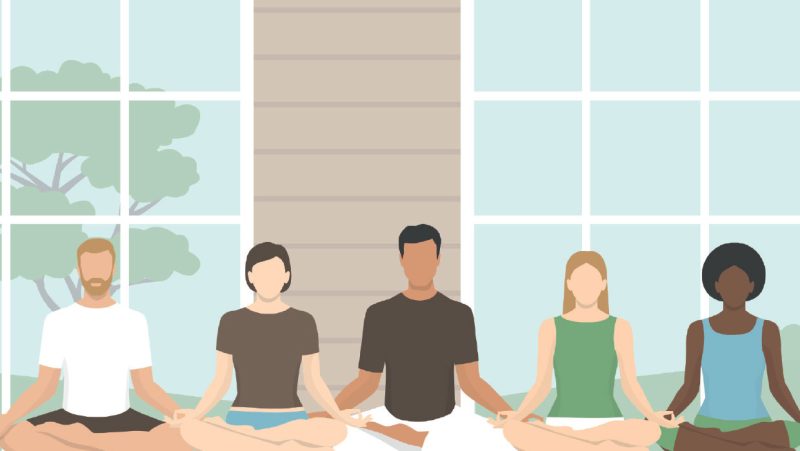There is no cure as yet for Multiple Sclerosis but yoga can most definitely help, writes Véronique Gauthier
Yoga for MS
Over 2.3 million people around the world have MS. Most patients are diagnosed in their 30s, two-thirds are women and although a lot of progress has been achieved in understanding the mechanisms of MS, no cure has yet been found. However, it is now widely acknowledged that lifestyle choices, such as diet and yoga, influence our ability to manage some MS symptoms.
One way to explain MS is to use an analogy between the nerves and electrical wires. In order to avoid short circuits, electrical wires are covered with plastic insulation. If this insulation is damaged, the current cannot flow properly. Similarly, the nerves in our central nervous system (brain and spinal cord) are covered with a protective sheath, called the myelin sheath, to ensure the messages from our brain to the various parts of our body are safely transmitted.
In MS, for some reason, the immune system attacks the myelin sheath. Whenever the myelin sheath is damaged, the messages are disrupted. There is a short circuit. After a while, scars or lesions (sclerae) start to form on the myelin sheath. Being diagnosed with MS is extremely difficult, in particular, because of its unpredictability. Anything is possible. Symptoms vary from sensory symptoms to blurred vision, walking difficulties or bladder problems. In some cases, symptoms come and go (Relapsing-Remitting MS). In others, they stay (Progressive MS).
However, there is some good news. And it is called neuroplasticity. Neuroscientists have recently discovered that the brain has an amazing ability to reorganise itself and change the way it works. Which explains phenomena like axonal sprouting – whereby undamaged axons grow new nerve endings and form new neural pathways, to replace other damaged nerves. We might not be able to cure MS and repair the lesions, but we can create new pathways and keep well. Yoga can help us do that. It can help us ‘repair’ our bodies. But yoga can give much more: it can also help us ‘heal’ and overcome the inner conflicts triggered by an MS diagnosis, with time, patience and gentleness.
Yoga
So which asanas should people with MS practice? Is headstand good for MS? What about inversions? For me, Pawanmuktasana first series has become my number one warm-up. Sitting on the floor, the student is invited to bend, circle and release the joints while doing ujjayi breath and focusing on the sensations in the joints. The practice starts with the toes (toe bending), then the ankles (ankle bending, rotation and crank), the knees (contraction, bending and crank), the hips (half-butterfly, rotation and full butterfly), the hands (clenching), the wrists (bending and rotation), the elbows (bending and rotation) and finally the head (bending, turning, rotating). The benefits are manyfold. Pawanmuktasana helps to release blockages and to increase joint mobility. It is a fantastic way to improve proprioception and reduce injuries. But it also teaches patience and inward focus.
When creating sequences, you can choose to address specific symptoms. If, on the other hand, you wish to address MS as a whole, vata-reducing sequences (including twists and forward bends) are always helpful. In Ayurveda, MS is considered a Vata disease affecting mostly pitta personality-types and these sequences bring a lot of comfort to people with MS.
Mudras
Because they can be done even when mobility or fatigue are serious constraints, mudras can easily be integrated into any yoga for MS practice. Here is one of my favourites: sitting in Vajrasana, on the heels, with the thighs together, or in Sukhasana, with your legs crossed, bring the tips of your thumbs, ring and little fingers together. The index and middle fingers are straight. Place the back of your hands on the thighs. This is called Pran mudra, the life mudra. It increases vitality and stimulates energy. It helps reduce fatigue which is often an issue for people with MS.
Self-discovery
Asanas, mudras and pranayama are wonderful tools to help our bodies restore and repair. However, the most important thing is not what we do, but how we do it. I always encourage students to focus on their breath or on the sensations they experience. In the former, it helps to quieten the mind. In the latter, it greatly improves proprioception. But most importantly, both may also gently lead to self-discovery. Both are invitations to explore the koshas and find out more about ourselves. And about MS. When I was diagnosed, I was advised to consider MS as my friend, which at the time I found absolutely impossible. Yoga has helped me to do so. Yoga has helped me bring the pieces together.
Read more from Véronique Gauthier and discover other yoga & MS resources at (tamingthewalrus.com)







